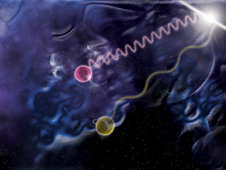Photons Traveling to
Earth
To the Earth's Atmosphere
A photon is an elementary particle
that is composed of electromagnetic energy.
Because photons do not require a medium in order
to travel they can be treated as particles
traveling in a stream; photons oscillate at
frequencies of 3 Hz up to 300 EHz (300 quintillion
hertz) which allow them to be treated as wave
also. Photons leave the Sun's atmosphere traveling
in a straight line with the frequencies and
wavelengths corresponding to a point on the
electromagnetic spectrum. When photons are
traveling from the Sun's atmosphere to the Earth's
atmosphere they are said to be in space. When in
space photons travel generally without restraint
and reach the universal speed limit, c, the speed
of light which is  meters per second or 671 million
miles per hour. Photons traveling at the speed of
light can be explained by Newton's first law of
motion which states that an object's velocity will
remain constant unless acted upon by a force.
Photons exit the Sun's atmosphere with the force
of energy pushing them outward, unless the photons
are acted upon by another force, their speed and
direction will remain constant. The photons
approach the Earth's atmosphere at the speed of
light, but once they come in contact with the
Earth's atmosphere they begin to interact with gas
molecules. The photons' interactions with gas
molecules is similar to the interactions they see
in the Sun's radiative zone. Gas molecules absorb
the photons and then instantly re-emit them. When
the photons are re-emitted they are sent about the
inside of the Earth's atmosphere in random
directions, although the majority of them fly
toward Earth's surface. meters per second or 671 million
miles per hour. Photons traveling at the speed of
light can be explained by Newton's first law of
motion which states that an object's velocity will
remain constant unless acted upon by a force.
Photons exit the Sun's atmosphere with the force
of energy pushing them outward, unless the photons
are acted upon by another force, their speed and
direction will remain constant. The photons
approach the Earth's atmosphere at the speed of
light, but once they come in contact with the
Earth's atmosphere they begin to interact with gas
molecules. The photons' interactions with gas
molecules is similar to the interactions they see
in the Sun's radiative zone. Gas molecules absorb
the photons and then instantly re-emit them. When
the photons are re-emitted they are sent about the
inside of the Earth's atmosphere in random
directions, although the majority of them fly
toward Earth's surface.

|

|
Representation
of a purple photon traveling
next to a yellow photon. nasa.gov
|
Gamma-ray
mapping of the universe.
nasa.gov
|
|

